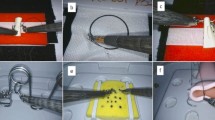Abstract
Computer vision (CV) feedback could be aimed as a constant tutor to guide ones proficiency during microsurgical practice in controlled environments. Five neurosurgeons with different levels of microsurgical expertise performed simulated vessel dissection and micro-suture in an ex vivo model for posterior computer analysis of recorded videos. A computer program called PRIME (Proficiency Index of Microsurgical Education) used in this research recognized color-labeled surgical instruments, from downloading videos into a platform, with a range of motion greater than 3 mm, for objective evaluation of number of right and left hand movements. A proficiency index of 0 to 1 was pre-established in order to evaluate continuous training improvement. PRIME computer program captured all hand movements executed by participants, except for small tremors or inconsistencies that have a range of motion inferior to 3 mm. Number of left and right hand movements were graphically expressed in order to guide more objective and efficacious training for each trainee, without requiring body sensors and cameras around the operating table. Participants with previous microsurgical experience showed improvement from 0.2 to 0.6 (p < 0.05), while novices had no improvement. Proficiency index set by CV was suggested, in a self-challenge and self-coaching manner. PRIME would offer the capability of constant laboratory microsurgical practice feedback under CV guidance, opening a new window for oriented training without a tutor or specific apparatus regarding all levels of microsurgical proficiency. Prospective, large data study is needed to confirm this hypothesis.
Similar content being viewed by others
Data availability
Not applicable.
Code availability
Not applicable.
References
Oliveira MM, Araujo AB, Nicolato A, Prosdocimi A, Godinho JV, Valle ALM, Santos M, Reis AB, Ferreira MT, Sabbagh A, Gusmao S, Del Maestro R (2016) Face, content, and construct validity of brain tumor microsurgery simulation using a human placenta model. Oper Neurosurg 12:61–67. https://doi.org/10.1227/NEU.0000000000001030
Oliveira Magaldi M, Nicolato A, Godinho JV, Santos M, Prosdocimi A, Malheiros JA, Lei T, Belykh E, Almefty RO, Almefty KK, Preul MC, Spetzler RF, Nakaji P (2014) Human placenta aneurysm model for training neurosurgeons in vascular microsurgery. Neurosurg 10(Suppl 4):592–601. https://doi.org/10.1227/NEU.0000000000000553
Ribeiro de Oliveira MM, Nicolato A, Santos M, Godinho JV, Brito R, Alvarenga A, Martins AL, Prosdocimi A, Trivelato FP, Sabbagh AJ, Reis AB, Maestro RD (2016) Face, content, and construct validity of human placenta as a haptic training tool in neurointerventional surgery. J Neurosurg 124:1238–1244. https://doi.org/10.3171/2015.1.JNS141583
de Montbrun S, Roberts PL, Satterthwaite L, MacRae H (2016) Implementing and evaluating a national certification technical skills examination: the Colorectal Objective Structured Assessment Of Technical Skill. Ann Surg 264:1–6. https://doi.org/10.1097/SLA.0000000000001620
de Oliveira MMR, Ferrarez CE, Ramos TM, Malheiros JA, Nicolato A, Machado CJ, Ferreira MT, de Oliveira FB, de Sousa CFPM, Costa PHV, Gusmao S, Lanzino G, Maestro RD (2018) Learning brain aneurysm microsurgical skills in a human placenta model: predictive validity. J Neurosurg 128:846–852. https://doi.org/10.3171/2016.10.JNS162083
Masters K (2019) Artificial intelligence in medical education. Med Teach 41(9):976–980
Car J, Sheikh A, Wicks P, Williams MS (2019) Beyond the hype of big data and artificial intelligence: building foundations for knowledge and wisdom. BMC Med 17(1):143. https://doi.org/10.1186/s12916-019-1382-x
Abecassis IJ, Sen RD, Ellenbogen RG, Sekhar LN (2020) Developing microsurgical milestones for psychomotor skills in neurological surgery residents as an adjunct to operative training: the home microsurgery laboratory. J Neurosurg 1-11.https://doi.org/10.3171/2020.5.JNS201590
Forestier G, Riffaud L, Petitjean F, Henaux PL, Jannin P (2018) Surgical skills: can learning curves be computed from recordings of surgical activities? Int J Comput Assist Radiol Surg 13(5):629–636. https://doi.org/10.1007/s11548-018-1713-y
Glaser B, Dänzer S, Neumuth T (2015) Intra-operative surgical instrument usage detection on a multi-sensor table. Int J Comput Assist Radiol Surg 10(3):351–362. https://doi.org/10.1007/s11548-014-1066-0
Sains P, Chana KS, Sridhar V, Sajid MS (2018) Pilot study on an innovative biosensor with a range of medical and surgical applications. BMC Res Notes 11(1):81. https://doi.org/10.1186/s13104-018-3163-6
Tolba RH, Czigány Z, Osorio Lujan S, Oltean M, Axelsson M, Akelina Y, Di Cataldo A, Miko I, Furka I, Dahmen U, Kobayashi E, Ionac M, Nemeth N (2017) Defining standards in experimental microsurgical training: recommendations of the European Society for Surgical Research (ESSR) and the International Society for Experimental Microsurgery (ISEM). Eur Surg Res 58(5–6):246–262. https://doi.org/10.1159/000479005
Mehrzad R, Prsic A, Basta M, Bhatt R (2019) A Cross-sectional survey study among hand surgeons in the United States on standardizing microsurgery training. J Hand Microsurg 11(1):35–44. https://doi.org/10.1055/s-0038-1669365
Mueller MA, Pourtaheri N, Evans GRD (2019) Microsurgery training resource variation among US integrated plastic surgery residency programs. J Reconstr Microsurg 35(3):176–181. https://doi.org/10.1055/s-0038-1668160
Author information
Authors and Affiliations
Contributions
Marcelo Magaldi Oliveira: conception or design of the work; acquisition, analysis, or interpretation of data for the work; drafting the work or revising; final approval.
Lucas Quittes: acquisition, analysis, or interpretation of data for the work.
Pollyana Helena Vieira Costa: conception or design of the work; acquisition, analysis, or interpretation of data for the work; drafting the work or revising; final approval.
Taise Mosso Ramos: acquisition, analysis, or interpretation of data for the work.
Ana Clara Fidelis Rodrigues: drafting the work or revising; final approval.
Arthur Nicolato: conception or design of the work; acquisition, analysis, or interpretation of data for the work; drafting the work or revising; final approval.
Jose Augusto Malheiros: acquisition, analysis, or interpretation of data for the work.
These authors contributed equally to this work.
Corresponding author
Ethics declarations
Ethics approval
COEP UFMG 0364.0.203.000-11
Consent to participate
All participants consent to participate.
Consent for publication
All participants gave the consent to the publication.
Conflict of interest
The authors declare no competing interests.
Additional information
Publisher’s note
Springer Nature remains neutral with regard to jurisdictional claims in published maps and institutional affiliations.
Supplementary Information
Below is the link to the electronic supplementary material.
Supplementary file1 Video 1 Placenta microsurgical simulation showing PRIME analysis during procedure (MP4 60747 KB)
Rights and permissions
About this article
Cite this article
Oliveira, M.M., Quittes, L., Costa, P.H.V. et al. Computer vision coaching microsurgical laboratory training: PRIME (Proficiency Index in Microsurgical Education) proof of concept. Neurosurg Rev 45, 1601–1606 (2022). https://doi.org/10.1007/s10143-021-01663-6
Received:
Revised:
Accepted:
Published:
Issue Date:
DOI: https://doi.org/10.1007/s10143-021-01663-6




